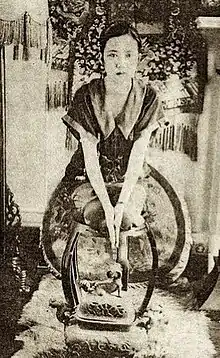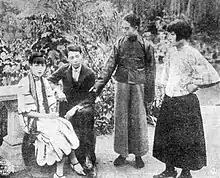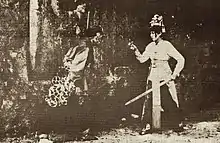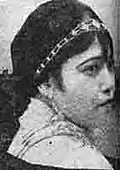Olive Young | |
|---|---|
 Actress and singer Olive Young plays a hammered dulcimer, which the Associated Press called a "butterfly harp". | |
| Born | June 21, 1903[1] St. Joseph, Missouri, U.S.[1] |
| Died | October 5, 1940 (aged 37)[1] Bayonne, New Jersey, U.S.[1] |
| Other names | Name used in China
Married name
Stage names
|
| Occupation(s) | Actress, Blues singer[1] |
| Years active | 1925–1932 |
| Spouse | Alfred C.S. Lum (married about 1933)[1] |
| Signature | |
 | |
Olive Young (June 21, 1903 – October 5, 1940), sinocized as Aili Yang (楊愛立) on the movie screen, was an American-born film actress in China.[2]
Of Chinese ancestry, she visited China, where she may have been the first female motion picture photographer and movie director in China.[3] Later in life she became an American actress and a touring Blues singer.[2] A cover-girl for Liangyou pictorial magazine, she was labeled a flapper, a career woman, part of the movement of modern independent women worldwide which also included China's "new-age woman" (新時代女性) or "modern miss" (摩登小姐), and the Japanese "modern girl".[2][4]
In 1926 she broke the taboo against kissing in Chinese movies, causing Chinese moviegoers to "gasp".[5]
Childhood
Olive Young was born in St. Joseph, Missouri, to a Chinese-American family.[6] Her father Dr. M. F. Young (Mon Fung Young) was born in California and worked as a doctor, running ads in the newspapers advertising his use of Chinese herbal medicines as cures for female diseases, chronic diseases, sexual weakness, kidney and stomach problems, nervous headaches, and rheumatism.[6] Her mother, Chun She Young, a native of China was a housewife. Mrs. Young was listed as Georgia Young, in the 1910 U.S. Census in Kansas City (Ward 6), born in Missouri; however Olive listed her mother as born in China on the 1930 U.S. Census. When Olive was a girl, her parents took her to live in China for "a number of years", staying in Hong Kong.[7] Afterward she attended school for a year in San Francisco and two more in Excelsior Springs, Missouri, before entering Christian College in Excelsior Springs.[6]
She came to public attention in October 1920 when she was "sixteen" and tried to elope.[6] The newspaper said she was 16, but if she was born in July 1903, she would have been 17. She had to be carried back to her father, who tried to have the White-Slave Traffic Act used against the man she wanted to marry, who was 20.[6] She was sent afterward to a boarding school in Salt Lake City.[6]
Acting

Although she had a college education and pressure from her father to study medicine, she rejected that. She told a reporter from the Oregonian, "The subject didn't interest me. I wanted adventure."[8]
She traveled to China in 1922 and while there she got into acting, getting her first opportunity with the China Sun Motion Picture Company.[8][6] She was to perform in Rouge with them, but ended up with the British American Tobacco Company, where she acted in her first three films.[6]
She stayed for several years, beginning a career in silent-picture movies.[6] Finding success, she decided to pursue acting in Hollywood. She returned to the United States in 1929.[6] Where she had starred in movies in China, a young attractive urban woman, in Hollywood she was only able to get typed roles.[2] She was signed to play the leading role of a movie, Fools Luck with Hoot Gibson, announced November 17, 1929, but there is no information that the movie was made or released.[9] (Apparently released under the title "Trailing Trouble". Same dates and costars as Fools Luck). In her final two films she didn't have named roles.[6] She played the maid in The Man Who Came Back and a singer who sang "a Cantonese ditty in Fu Manchu's underground speakeasy" in The Mask of Fu Manchu.[6]
Following her film career, she moved on to music, traveling and performing a mix of blues and Chinese music.[6]
Movies
It was thought that none of Young's Chinese movies are known to have survived. However, there is now a partial clip of one of her movies, Daxia Gan Fengchi (大侠甘风池 Dà xiá gānfēngchí) that has been recovered and is online.[10][11] In this clip there is only a glimpse of Olive Young, near the end, playing a young woman. The only other film footage of her is in her American movies, Trailin' Trouble, The Man Who Came Back, and The Mask of Fu Manchu.
British American Tobacco Company, Shanghai
Fei Fei Film Company, Shanghai
Great Wall Film Company, Shanghai

- 1926 The Ways of Youth or Kule Yuanyang (苦樂鴛鴦 Kǔ lè yuānyāng Bitter Music),[12][3] (starring role)
- 1927 A Flapper's Downfall (浪女穷途 Làng nǚ qióngtú A Woman's Poor Way)[12][3]


- Movie takes from Chinese mythology. Nezha (played by Zhang Zede) is the child of Li Jing (played by Lei Xiadian) and his wife (played by Liu Hanzhen). In the legend, he runs afoul of Shiji Niangniang, a sort of stone spirit, played in the movie by Olive Young.[15][16]
- Kan Feng-chi is the movie's hero, whose self-imposed function was to fight the unkind rich and to help the oppressed poor. Not enough of the movie has survived to make Olive's role clear.[18]
China Sun Film Company, Shanghai
New Century Film Company, Shanghai
- 1928 Romance in a Poor Village (窮鄉艷遇 Qióng xiāng yànyù Poor town encounter)[12]
Nansing Film Company, Indonesia
Hollywood, California
- 1930 Trailing Trouble, Hoot Gibson Productions/Universal Pictures, Hollywood[12]
- 1930 Ridin' Law, Biltmore Productions/Big 4 Film Corp.[12]
- 1931 The Man Who Came Back, Fox Film Corp. (not a named role, plays a maid)[12]
- 1932 The Mask of Fu Manchu, Metro-Goldwyn Mayer (non-credited role as a singer)[12]
References
- 1 2 3 4 5 6 7 8 9 10 11 12 Jay, Alex (January 3, 2014). "Olive Young". Chinese American Eyes. Retrieved July 12, 2018.
- 1 2 3 4 "In Search of Yang Aili [Yang Aili aka Olive Young ... or vice-versa]". chinesemirror.com. Archived from the original on April 16, 2016. Retrieved July 12, 2018.
Olive Young was her birth name. In Chinese film credits she was billed as "Yang Aili" 杨爱立, a Sinocized version of her actual name... We do not know for certain why her movie career ended at that point, but she probably ran up against the same lack of meaningful roles for Asians that drove Anna May Wong to Europe.
- 1 2 3 4 5 6 7 "楊愛立(1903–1940) :持攝影機的女人? [translation: Yang Aili (1903–1940): A woman with a camera?]". Retrieved July 9, 2018.
[translated: ...main actress of the Great Wall after Wang Hanlun, starring in "Bitter Music" (1926), "Women's Poor Way" (1927), "One Arrow" (1927), "Where Behind the film (1927), "Flame Mountain" (1927) and "The Devil's Shadow" (1928) and other films...
- ↑ Lin, Ziren. "Review How is China's "Modern Girl" made? "Liangyou" pictorial published 90 years". Interface News. Retrieved July 12, 2018.
Liangyou" is at a time when the modern girl's trend has taken root in China...
- ↑ "Asia 1934". Chinese American Eyes chimericaneyes.blogspot.com. Retrieved August 20, 2018.
Asia [magazine] 1934... In 1926, however, Olive Young, an American-born Chinese cinema star, ventured a kiss that was shown only in silhouette through a semitransparent screen. Chinese audiences gasped when they saw it...
- 1 2 3 4 5 6 7 8 9 10 11 12 13 Durian, Dave (February 16, 2014). "Olive Young's Great-Depression Blues". chiseler.org. Retrieved July 12, 2018.
- ↑ "The Evening Missourian (Columbia, Missouri) October 7, 1919". Evening Missourian. October 7, 1919. Retrieved July 12, 2018.
- 1 2 "The Oregonian November 7, 1929". Oregonian. November 7, 1929. Retrieved July 12, 2018.
- ↑ "Cleveland Plain Dealer (Ohio) November 17, 1929". Cleveland Plain Dealer. Cleveland, Ohio. November 17, 1929. Retrieved July 12, 2018.
- ↑ "【武侠/无声】大侠甘凤池 1928年 【残片 23分钟】 [translation: [martial arts / silent] heroes Gan Fengchi 1928 fragments 23 minutes]". bilibili.com. Retrieved July 14, 2018.
[note: This movie is in the public domain. This clip has commentary by uploaders laid over the footage.]
- ↑ "大侠甘凤池 Gan Fengchi (1928)". 1905.com. Retrieved July 14, 2018.
[note: This movie is in the public domain. Clip has proven difficult to watch, but is there.]
- 1 2 3 4 5 6 7 8 9 10 11 12 13 14 15 16 17 18 Durian, Dave (October 24, 2013). "Olive Young 楊愛立: An Annotated Filmography (1925–1932)". softfilm.blogdpot.de. Archived from the original on April 15, 2015. Retrieved July 12, 2018.
{{cite web}}: Check|url=value (help) - ↑ "Langdie (1926)". IMDb. Retrieved July 8, 2018.
Director: Jue-xian Xue...Olive Young...Tang Xueqian...
- ↑ Edward, Kelvin (August 28, 2014), Olive Young: An Annotated Filmography (1925–1932),
Sit Kok-sin...decided to make his own movie... pseudonym Zhang Fei...set up the Fei Fei Film Company... singed moth is ...licentious playboy.
- ↑ "哪吒出世 [translatin:Nezha was born]". tv.sohu.com. Retrieved July 14, 2018.
- ↑ Shahar, Meir (January 23, 2014). Kieschnick, John; Shahar, Meir (eds.). India in the Chinese Imagination: Myth, Religion, and Thought. p. 39. ISBN 978-0-8122-4560-8.
- ↑ "Yank on the Yangtse". Oakland Tribune. Oakland, California. September 29, 1935. Retrieved July 14, 2018.
- 1 2 "Stills of heroes Gan Fengchi". Retrieved July 14, 2018.
[newspaper or magazine advertisement clipped] Khan-the Great Knight-Errant, A Great Wall Production, Kan Feng-chi is the hero, whose self-imposed function was to fight the unkind rich and to help the oppressed poor. Very fine direction. Credit should go to K. L. Wang who portrays excellently as the villain.
- ↑ "《Hero Gan Fengchi》(1928)". chinesemirror.com. Archived from the original on April 16, 2016. Retrieved July 12, 2018.
Daxia Gan Fengchi (1928) 大侠甘风池 (Hero Gan Fengchi...Direction: Yang Xiaozhong. Screenplay: Chen Zhiqing. Cinematography: Cheng Peilin. Cast: Wang Guilin, Yang Aili, Liu Hanjun, Hong Jingling, Wang Zhengqing, Tan Jianqiu.)
- ↑ Meyer, Richard J. (January 2009). Jin Yan: The Rudolph Valentino of Shanghai, Volume 1. Hong Kong University Press: Hong Kong. p. 15. ISBN 9789622095861.
Rexue Nan'er (The Hot Blooded Man)
.jpg.webp)

